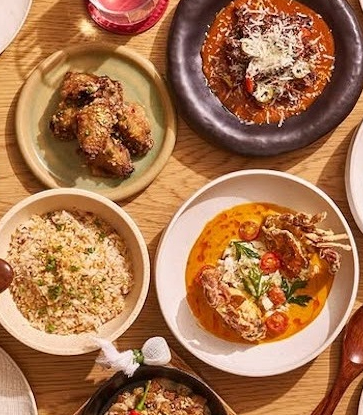Preparation for a Nasi Padang will require more than a single person, for a home-cooked meal it is not. This miniature feast requires a small kitchen brigade — usually made up of an all-woman crew, for the Minangs are a matriarchal race. Each cook will be responsible for preparing her allotted contribution to the eventual spread: either a delightfully piquant chicken curry, a deep-flavoured beef rendang, or a batch of golden-crusted mashed potato croquettes called perkedel (a culinary term adapted from the Dutch frikadel).
Traditionally, there are two ways with which Nasi Padang is presented: "hidang" (served) or the more common "pesan" (order).

The "hidang" approach is unique to Nasi Padang, where the diners do not need to place their orders. Instead, the servers will place 12 to 14 saucers, each filled with a different cooked item, in front of the diner, on his/her table. The diner will only need to pay for the dishes that he/she has eaten. Not for the queasy here, as untouched plates may be “recycled” — that is, served to the next hidang set table. But as a temptation tool, it’s absolute genius: for who can resist a dazzling array of aromatic, delicious-looking dishes, tantalisingly set in front of oneself. The “look but don’t touch, unless you want to pay for it” approach has led to many a busted diet.

For the "pesan" approach, the diner will go up to a serving counter, where all the cooked dishes are being displayed and selects his/her viands. The order will then be sent to the dining table. This method of serving steamed rice with a plethora of cooked dishes to choose from has also been adopted by other local culinary cultures — Nasi Campur in Singapore and most Malaysian states, Nasi Sumatera in Kelantan, and, perhaps the most famous of them all — the Indian-Muslim Nasi Kandar in Penang.

Different Nasi Padangs Across the Region
The Minangs have a tradition called merantau (“migrating”), a mercantile, profit-driven sense of adventurism that propels this prodigious group to settle and conduct business in faraway lands, preferably within the Malay-Muslim world.
Historically, Malacca was a coveted destination, as it was the epicentre of Malay-Muslim culture in the region — a bustling, cosmopolitan trading centre in the 15th century, where various ethnicities from across the Nusantara (a geographical swathe covering much of modern-day Indonesia and Malaysia) met to barter and trade. The Minangs settled into this milieu, setting the mise-en-scène for what is to be a Malay culinary renaissance in the region for many years to come.

The Portuguese conquest of Malacca in 1511 triggered a panicked outflow of the Malay-Muslim populace (the Minangs among them) to other parts of the Malay peninsula and Singapore. As they settled together, the Minang and Malay cooking styles of this far-flung diaspora converged naturally, giving rise to the familiar dishes one sees everywhere today: the signature slow-cooked, fork-tender beef rendang is a case in point. The rendang is usually served in festive feasts by the Malays in Malaysia and Singapore, especially during the Hari Raya Eid al-Fitr, held at the end of Ramadan. The dish traditionally demands slow, patient cooking of preferably a sinewy cut of beef, so that the end-result has a melt-in-the-mouth texture and deep flavours. The spicing for a rendang is mild, in comparison to the fiery curries that Padang cuisine is renowned for.
From its Padang roots, the rendang evolved into different variants as it spreads throughout the region: the dark-as-night Rendang Tok of Perak, the yellow-hued Rendang Cili Padi of Negeri Sembilan (a Malaysian state famous for its Minang heritage), and the Rendang Opor of Pahang that takes up to five hours of patient, constant stirring over a low heat. Each Malaysian state has its own take on the dish, localised to please the local palate.

From Padang with Love
In multi-cultural Malaysia and Singapore, Nasi Padang’s effusive attraction cuts across ethnic and socio-economic lines. Packed, noisy restaurants serving Nasi Padang is a common sight in the streets of Singapore, as they are in Kuala Lumpur or Penang. Here are some popular, must-try Nasi Padang dishes:
Dendeng Balado: crisp-fried, thin slices of beef, topped with red chilli sambal
Gulai Kikil: spiced beef tendon, where the gelatinous tendon is slow-cooked, Minang-style, giving the resultant dish a creamy, turmeric-scented flavour; explosive, tiny bird’s eye chillies are added to undercut the coconut milk richness (this is a recurring pattern across many Minang-influenced dishes)
Gulai Nangka: wedges of young jackfruit, cooked Minang-style (with coconut milk, tinged yellow using fresh turmeric, and spiked with bird’s eye chilli)
Pecal Lele: pan-fried catfish, served with a sambal terasi (chilli-fermented shrimp paste) dip
Ikan Goreng Cabe Ijo: pan-fried fish, topped with ground green chilli sambal
Telur Balado: golden-crusted eggs that are first hard-boiled, then pan-fried in oil, and then topped with ground red chillies
Daun Singkong: blanched cassava leaves, one of the must-haves for a Padang meal
Krupuk or Keropok: deep-fried crackers made from starch, flavoured with fish, prawns and/or flavour enhancers; Whilst the Malays consume krupuk as a snack, Indonesians regard krupuk as a garnish, to be eaten with rice and other dishes together as part of a meal
Sambal Ijo: green chilli relish, a staple and must-have in any authentic Nasi Padang meal
Sambal Merah: red relish; this is often provided to cater to the local Malay taste preferences
For most Malaysians and Singaporeans, having a Nasi Padang meal provides the delightful opportunity for one to compose a bespoke lunch or dinner plate for oneself, with the flexibility to select one’s preferred meats or vegetables, and the various combinations to enjoy them with. Oftentimes, the sheer variety of dishes available and the permutations of having them, means one can come back to the same place again and again for days, or even weeks on end, and yet be able to enjoy a different gustatory experience each time. To paraphrase Samuel Johnson, “When a man is tired of Nasi Padang, he is tired of life.”
Where to enjoy Nasi Padang in Kuala Lumpur:
Congkak (Bib Gourmand, MICHELIN Guide Kuala Lumpur & Penang 2024)
Dancing Fish (Bib Gourmand, MICHELIN Guide Kuala Lumpur & Penang 2024)
Where to enjoy Nasi Padang in Singapore:
Hjh Maimunah – Jalan Pisang (Bib Gourmand, MICHELIN Guide Singapore 2024)
Tambuah Mas (Orchard) (Selected, MICHELIN Guide Singapore 2024)




















